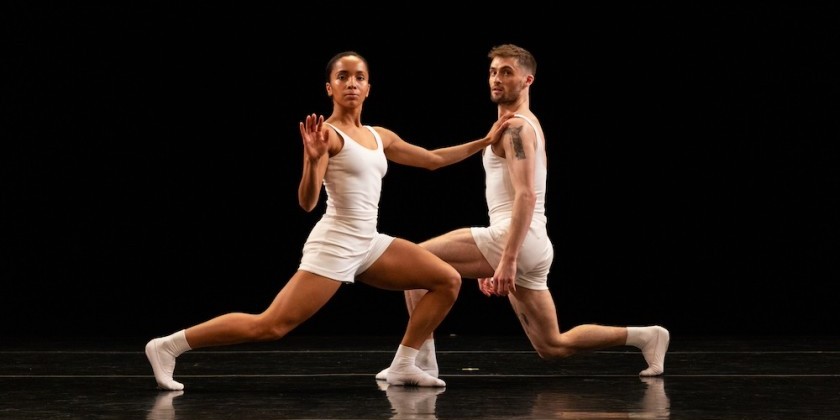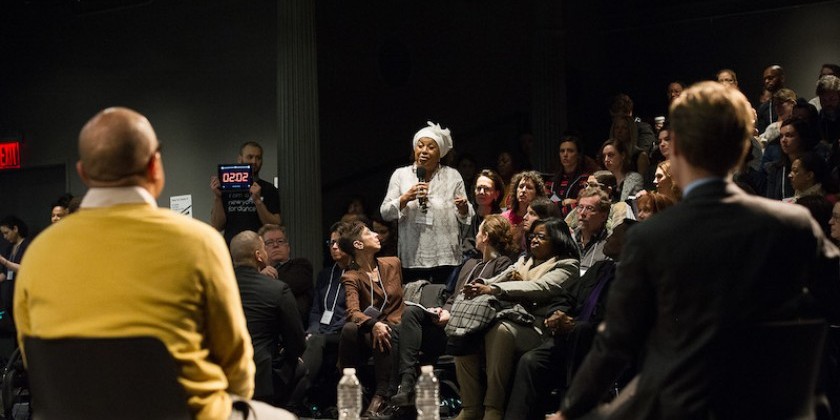The Dance Enthusiast Hits The Street: Dance/NYC Symposium (Part 1)

Information, Not Dialogue
DanceNYC’s Annual Symposium is a wonderful place to receive information. This year’s event took place at the new Gibney Dance space on 280 Broadway and featured upwards of twenty workshops, individual consultations, and a number of other resources including tables of pamphlets and cards from the day’s sponsors and panelists and, thankfully, plenty of coffee. This was my first year attending; however, dancer and arts administrator Kendra Ross, who attended on behalf of Cumbe: Center for African and Diaspora Dance and STooPS, felt the Gibney space served the symposium much more than previous locations. “Being in Gibney's new space and having her speak on different panels truly allowed me to gain lots of wonderful information,” Ross said, “and to see the fruits of the labor of which the panelists were speaking.”

Seeing the signage outside the studios bearing statistics about dance in each borough, then witnessing symposium’s participants squealing hugs that filled the hallway - made 280 Broadway feel even more like a home for the New York dance community.
It was with the notion of community that I started my day. Lucy Sexton, Director of the NY Dance and Performance Awards/The Bessies, led a conversation titled “The Bessies on ‘Community’”. She opened the dialogue by sharing that Miguel Gutierrez, who apparently questioned the awards’ recent shifts, inspired her to pose questions about community. According to veteran dance writer Eva Yaa Asantewaa, the 2015 awards ceremony was “one of the feeling-goodest Bessie shows on record.” I too shared those good feelings as I watched the diverse array of artists recognized that evening in October. Gutierrez seemed to doubt the awards’ newly inclusive values and challenged the need for varying dance communities to come together annually at the Apollo Theater.
The dialogue that followed took on two focal points-- defining community and defining needs. Sexton chose the long table format, invented by performer/professor Lois Weaver, and invited anyone in the audience to take a seat at the table. Very few of us took on that challenge. Instead we listened (and I tweeted) as David Thompson and Blondell Cummings spoke of ecosystems and overlapping communities while Edisa Weeks suggested that in order to connect we must find our shared values. Elizabeth Zimmer, former dance editor for the Village Voice, challenged the value of dance to the broader society, especially after being told by one of the senior editors that “90% of our readers don’t care about dance.” The hour ended in a seeming consensus that we are many dance communities and the Bessies support us all by, in the words of Gus Solomons, Jr., “[announcing] to the universe that dance and performance are important to the world.”

My day continued with “NYC Dance Facilities & Geographic Equity,” a panel discussion examining dance spaces across the boroughs. It eloquently showcased the immense value of spaces created by artists for artists. With panelists from Queens (Topaz Arts’ Paz Tanjuaquio), the Bronx (BAAD’s Charles Rice-Gonzalez), and Staten Island (Second Saturday Staten Island Art Walk organizer Melissa West), the hour offered exemplary models of artists who have found their way in these “outer-borough” communities and often offer perks (like space at $8/hour) that facilities in Manhattan couldn’t even consider.
This made the transition to conversations on corporate giving a bit ironic. While the presenters broadened the scope of corporate giving to include neighborhood-owned businesses, it is a stretch to think of artists who own outer-borough dance facilities in the same breath as corporate sponsors. I witnessed the presentation of DanceNYC’s newest research and the sharing of two case studies in corporate partnership – Gibney Dance with EILEEN FISHER and Brooklyn’s Dancewave with Forest City Ratner Companies. Both partners touted how “un-corporate” they are in their artistic relationship, which led me to ask if they were simply anomalies, or examples of a shift in thought. Despite Jacobowitz’s response of being “an optimist” and her invitation to “just step forward and take it,” I remain a skeptic. Thankfully, EILEEN FISHER’s Reisa Brafman shared that her company is beginning to engage with more businesses to help shift the thinking and guide them to be more supportive of the arts and other issues with social impact.

My symposium experience closed with the conversation that drew me to attend, “Power, Privilege, & Perception: Voice in Race and Dance.” Prior to 2015, I did not feel that DanceNYC’s Symposium was a space for me or the often marginalized artists I serve with my business, PURPOSE Productions. When I heard about how DanceNYC Junior Committee’s 2010 Census defined the average dance worker, Clare – a 28 year old, white woman who identifies most closely with ballet and modern dance forms and lives in Brooklyn - I had a similar reaction to my dear friend, choreographer and Junior Committee member Sydnie L. Mosley: “That census provided an entry point for the larger committee to take notice of what I knew about JCOMM from the first day I walked in the room: that the committee was only connected to and serving the needs of that particular demographic.“ Clare was not news to us.
I never questioned the symposium’s value, but rather understood that it seemed to best serve the institutions that I don’t often engage with. As Joseph Hall, Programs Manager at 651 ARTS, observed, “It did feel most geared toward organizations and administrators so I missed the voices of independent artists who I think should always be the loudest at the table.” While the conversation about race drew me into the room, Hall echoed one of my largest critiques of the day. With the exception of the long table format Lucy Sexton employed and the one-on-one consultations, many of the discussions took place with panelists seated at (sometimes elevated) tables talking to, not with, the attendees in the room. I repeat, “the Dance/NYC Symposium is a wonderful place to receive information, but it’s not conducive to dialogue.”

Erica Frankel, Director of Communications for National Choreography Month said, “It is clear that our field's greatest opportunities are born from conversation, convening, and collaboration. Dance/NYC created a space for these this weekend.” I, however, beg to differ.
As someone who often engages in deep community dialogue, including my own recent experience as a panelist in Dancing While Black’s Cultivating Community conversation at BAX/Brooklyn Arts Exchange’s Artist Services Day, there are two things I have learned. It takes trust to engage in a dialogue amongst what Blondell Cummings calls “overlapping communities.” And it takes time for that discussion to move past the repetitive and reactionary, to one that is productive and forward moving. One hour sessions and tables of separation convey neither time nor trust. I watched, vaguely annoyed but far from surprised, as a number of conversations throughout the day simply scratched the surface. “I would love to see the symposium extended to a longer day or multi-day weekend,” suggested Kendra Ross. The time factor along with the number of overlapping sessions was mentioned by a number of attendees I spoke to in passing.

I could spend days unpacking the conversation on race and dance, despite only attending the final section. Instead, I’ll share more reflections from 651 ARTS’ Hall, who has only been supporting the New York dance community for the past six months. “In my naïveté, I thought I would hear new conversations different than that of Pittsburgh's from where I moved. Instead, it was very familiar and even predictable. There is certainly importance in having these conversations, if only to remind us all of the need to push forward and put words into action, but it's taxing for those small, underfunded organizations and artists who are already doing the action.” As both owner and supporter of one of those small organizations, I couldn’t agree more.
The DanceNYC Symposium is a wonderful place to gather information across tables and hug in hallways, but I did not experience any of the dialogue that, as scholar and educator Aimee Meredith Cox would say, made me “uncomfortable, unsure, and confused” and pushed us beyond “the arrogance of our assuredness.” The only discomfort I noticed was among some attendees and panelists who I know personally. We want to dig deeper and reach farther. We don’t care to talk about diversity anymore because we’re working towards justice.
We’ll see what 2016 brings. Someone suggested cookies. I second that as well.
Eva Yaa Asantewaa and Sydnie L. Mosley












